Designing a Nuclear Waste Warning Symbol That Will Still Make Sense in 10,000 Years
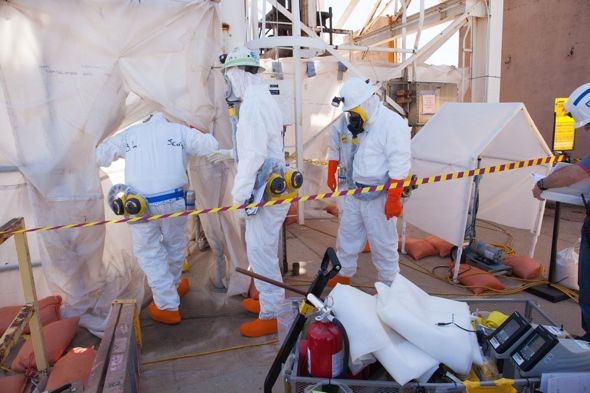
Courtesy of WIPP
Roman Mars’ podcast 99% Invisible covers design questions large and small, from his fascination with rebar to the history of slot machines to the great Los Angeles Red Car conspiracy. Here at the Eye, we cross-post new episodes and host excerpts from the 99% Invisible blog, which offers complementary visuals for each episode.
This week's edition—about designing warning symbols for nuclear waste that will last for the next 10,000 years—can be played below. Or keep reading to learn more.
In 1990, the federal government invited a group of geologists, linguists, astrophysicists, architects, artists, and writers to the New Mexico desert, to visit the Waste Isolation Pilot Plant. They would be there on assignment.
The Waste Isolation Pilot Plant is the nation’s only permanent underground repository for nuclear waste. It holds radioactive byproducts from nuclear weapons manufacturing and nuclear power plants. WIPP was designed not only to handle a waste stream of various forms of nuclear sludge, but also more mundane things that interacted with radioactive materials, such as tools and gloves.
WIPP, which is located deep in the New Mexico desert, was designed to store all of this radioactive material and keep us safe from it.
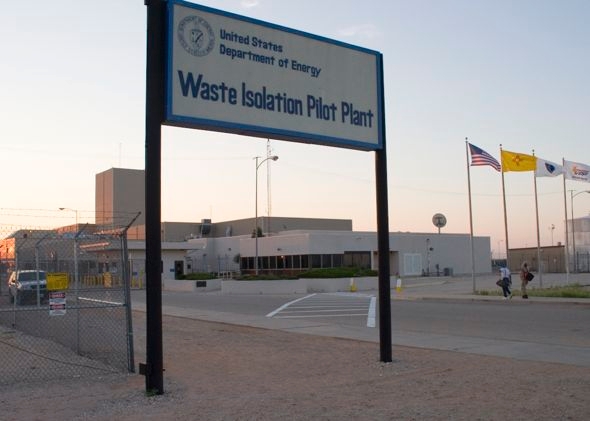
Courtesy of WIPP
Eventually, WIPP will be sealed up and left alone. Years will pass and those years will become decades. Those decades will become centuries and those centuries will roll into millennia. People above ground will come and go. Cultures will rise and fall. And all the while, below the surface, that cave full of waste will get smaller and smaller, until the salt swallows up all those oil drums and entombs them. Then, all the old radioactive gloves and tools and little bits from bombs—all still radioactive—will be solidified in the earth’s crust for more than 200,000 years. Basically forever.
Storing something safely forever is a huge design problem; in fact, the jury’s still out on whether WIPP has solved the basics of the storage problem at all. In February 2014, a leak was detected that exposed several workers to radiation, and WIPP has been closed since. The Department of Energy now predicts that it could be up to three years before WIPP is fully operational again.
We know these facts because we can look them up and read the news in a shared language. The problem that the aforementioned panel was convened to address was how to communicate information to people 10,000 years in the future.
This WIPP site is going to be radioactive for hundreds of thousands of years, though this panel was only responsible for keeping this place sufficiently marked for humans for the next 10,000 years—thinking beyond that timeframe was presumed to be impossible.
Nevertheless, 10,000 years in the future is still fairly inconceivable: 10,000 years ago, the biggest new technology spreading across the planet was farming. Culturally, we share almost nothing with people alive back then. Who knows what the world will look like 10,000 years from now?
The panel began by thinking about language. But language, like radioactive materials, has a half life. Beowulf, from only 1,000 years ago, is incomprehensible today.
The panel also considered symbols, which seemed like they might be more universal. A smiley face seems to have a global appeal. And face logos have already been used as warnings.
Carl Sagan (who was invited to participate on the panel but had a schedule conflict) sent the WIPP panel a letter saying this whole marker problem was easily solved with the right symbol, and he knew just the one: the skull and crossbones.
But symbols can also shift over time. The skull and crossbones actually began not as a symbol of death, but a symbol of rebirth. The earliest uses of it are in religious paintings and sculptures from the Middle Ages. At the foot of a cross where Jesus is crucified, you'll often find depicted a skull with two bones in the shape of a cross, not an X. The skull is supposed to be that of Adam.
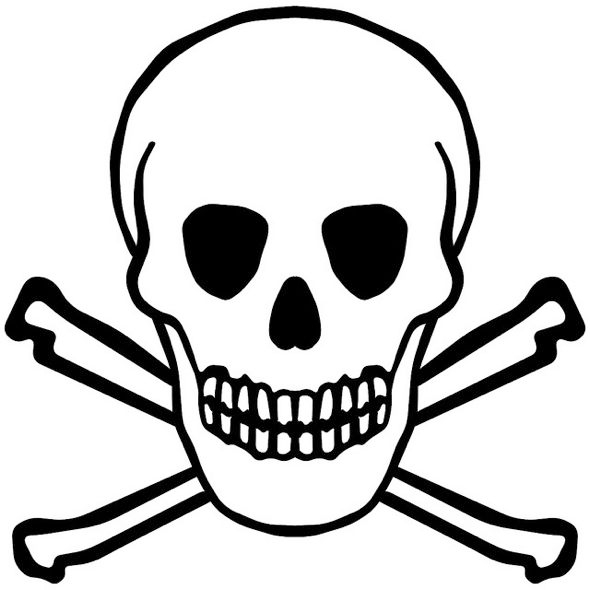
Simon Strandgaard via Flickr
A few centuries later, ship captains started to draw little skulls and crossbones in their logs, next the names of sailors who had died at sea. Sailors came to associate the symbol with death.
Fast forward another century. Pirates realized they could use symbolism to terrify their targets into compliance. But there were several different designs besides the Jolly Roger that pirates used, including an hourglass, and a bleeding heart. The banner of Edward Teach (also known as “Blackbeard”) had both.
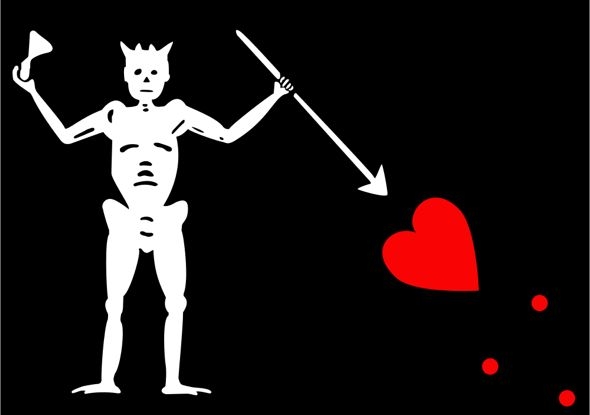
Traced from a scanned image of Blackbeard the Pirate by Angus Konstam, courtesy Fred the Oyster via Flickr
Then, in 1720, a pirate named Calico Jack Rackham was captured and put on trial. The trial was the sensational story of the day, and everyone in England was talking about it. And it just so happened Calico Jack’s symbol was the Jolly Roger, though in his case the bones were replaced with a pair of crossed swords.
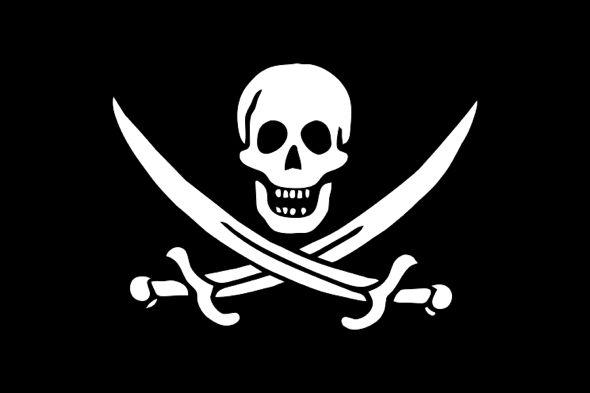
Via Wikimedia Commons
After that trial, the skull and crossbones permeated culture as a symbol of danger. By the late 1800s, it was being used as a symbol for poison. Then in the 1940s, the Nazis adopted it for their SS death's head divisions.
The skull and crossbones came to be associated with danger and death around the world. But its meaning didn’t truly become universal. In the past few decades, the Jolly Roger has gone mainstream. Now you’ll see it on backpacks, toddler onesies, and even on water bottles. So much for indicating poison.
Ruling out language and symbols, the panelists thought about using some visual storytelling. A landscape artist and architect named Mike Brill envisioned huge needles jutting up from the ground—a “landscape of thorns”—to make people scared of being in this dangerous place. But there’s no way of knowing that this ominous landscape wouldn’t become an attraction in itself and actually invite people to explore it.
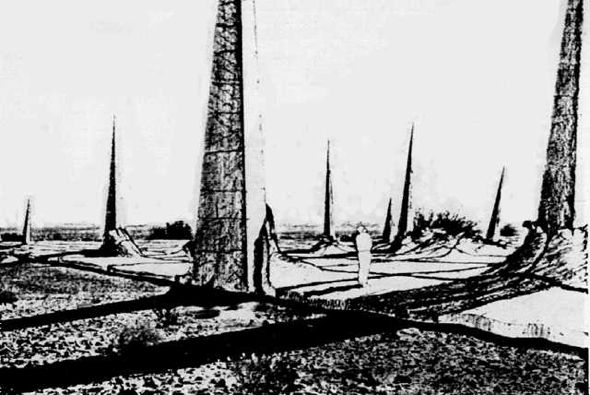
Mike Brill. Courtesy of WIPP.
Our favorite solution at 99% Invisible, though, didn’t come from the WIPP brainstorm—rather, it came out of the Human Interference Task Force, a similar panel that was pulled together in 1981 for the now-defunct Yucca Mountain project. It was proposed by two philosophers, Françoise Bastide and Paolo Fabbri.
Bastide and Fabbri came to the conclusion that the most durable thing that humanity has ever made is culture: religion, folklore, belief systems. They may morph over time, but an essential message can get pulled through over millennia. They proposed that we genetically engineer a species of cat that changes color in the presence of radiation, which would be released into the wild to serve as living Geiger counters. Then, we would create folklore and write songs and tell stories about these “ray cats,” the moral being that when you see these cats change colors, run far, far away.
This is all a lot of effort to protect people that our great great great grandkids will never know. All while people now, in our own time, are already harmed by the results of nuclear weapons manufacturing.
The town of Tallevast, Florida, is a small, predominantly black community south of Tampa. In the 1960s, a beryllium processing plant was set up in the middle of town to manufacture components for nuclear bombs and build pieces of the Hubble space telescope. It turned out that this plant was never very good about dealing with its waste, and beryllium dust and other toxins made their way into town’s the ground water.
Tallevast residents started noticing that a lot of people were getting diagnosed with diseases including berylliosis, which you get from exposure to beryllium. Tallevast residents filed a lawsuit against the company that purchased the plant in 1996, Lockheed Martin, and were awarded damages for Lockheed's handling of the contamination.
Lockheed Martin happens to be the parent company of Sandia National Labs, the corporation that runs the WIPP site in New Mexico.
Which kind of makes you wonder if the best way to protect people 10,000 years from now might not be to just make sure we take care of people alive today.
To learn more, check out the 99% Invisible post or listen to the show. Or read a Slate story about this labeling challenge.
99% Invisible is distributed by PRX.
